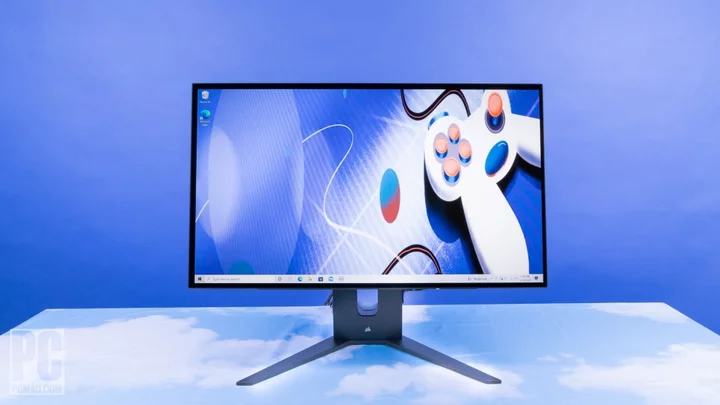After experimenting with the Xeneon Flex, a head-scratching, bendable curve-it-yourself monitor, Corsair makes a return to form with the Corsair Xeneon 27QHD240 OLED ($999). You'll find no curves here, but still plenty to like in this 1440p, 27-inch OLED gaming monitor with a razor-thin screen and a sky-high 240Hz refresh rate. It’s a fantastic monitor, with plenty of I/O ports and a petite footprint, as well as some impressive visual fidelity thanks to its LG panel technology. A slightly overblown color gamut leads to some uneven color accuracy at peak brightness, but that's a blemish we’re willing to overlook simply because of how great everything else is. Corsair has cooked up one of our favorite OLED monitors so far for gamers who can spend a lot to get a lot.
A New 27-Inch Contender
Corsair’s latest OLED ditches the curve, opting for a thin, flat panel that rests atop a port hub, which in turn connects to a slim, black stand. The design gives the monitor an almost-too-thin appearance, and at just 13.8 pounds, it is a featherweight. But looks can be deceiving, as the Xeneon's wiry frame is sturdier than most. The two-prong stand’s rubber feet render the monitor completely immobile, which makes adjustments to height and tilt a breeze. And given its virtually non-existent bezels, you’ll have all 27 inches of gorgeous OLED real estate at your disposal without any encroaching distractions.
The minimalist, lightweight design gives the monitor a small figure, which helps it fit into a variety of different places, too. Corsair’s monitor measures in at 20.8 by 23.7 by 8.8 inches (HWD), a perfect match for crowded desks. It’s thinner than Sony’s Inzone M3, but its maximum height extends just a few inches further. Healthy tilt and pivot options also give the monitor plenty of dexterity, and a lack of RGB lighting spares the monitor from a Lite-Brite aesthetic.
Turning the monitor around, you’ll find two vertical rows of I/O ports flanking the 100-by-100mm VESA mount, a contrast to the usual horizontal row of ports that has become commonplace. Here you’ll find four USB Type-A ports, USB-C upstream and power-delivery ports, two HDMI 2.1 ports, a headphone jack, and a DisplayPort. You'll find no speakers on this monitor, though.
Despite the omission of a sound system, the monitor is arranged efficiently. It does a great job at naturally handling cord congestion while maintaining a trim design.
One nifty addition is the inclusion of a proximity sensor at the bottom of the monitor. When your hand hovers near, the display shows exactly where to find the OSD control, power button, and input toggle. Gone are the days of tilting, adjusting, or fondling your monitor looking for the power switch. It’s an addition that I hope catches on.
The Xeneon’s OLED screen is gorgeous and well worth the trade-off of a 4K resolution, in my opinion, at this screen size. The 2K resolution is a sweet spot for the 27-inch panel class that works well for midrange PCs, as well as the Xbox Series X and PlayStation 5 (especially if you prefer performance over visual quality), though you’ll get tons of mileage no matter the video source. OLED screens are in a league of their own, and they outclass IPS displays in almost every category, including power efficiency, color gamut, and viewing angles.
It's the only technology that provides "true blacks," with the black pixels actually turned off to create zero-light zones and maximum contrast. OLED's downsides include a significantly higher price than IPS, TN, or VA panels, and the potential for burn-in from a static image being left on screen too long. However, Corsair does offer a very generous three-year warranty that includes burn-in protection.
This Corsair monitor also employs LG’s Meta technology, announced at CES 2023, which the company claims improves viewing angles and brightness, up to 30% and 60%, respectively. Every OLED pixel is self-lit with a micro lens array (MLA) to enhance brightness and clarity. This improvement mostly comes across in naturally lit scenes and is sure to be a hit with the National Geographic crowd. Interestingly, despite the panel being an LG component, the technology was missing from the recent LG UltraGear 45 OLED.
The screen supports AMD FreeSync Premium and is Nvidia G-Sync-compatible, both of which help increase your chances of smooth gameplay without screen tearing. We’ll take a closer look at performance in our next section.
Testing the Corsair Xeneon 27QHD240 OLED: Seeing Is Believing
The Corsair makes an impressive entrance, and its gorgeous 27-inch panel promises an optimized gaming experience, but does it deliver? The 2K OLED space is growing, so we pitted the Xeneon against some recent OLED favorites (the Alienware 34 Curved QD-OLED Gaming Monitor and the LG 45 UltraGear) as well as some recent IPS and VA panels of similar size. And to quantify the differences, we ran a few benchmark tests using our Calman monitor calibration software, Murideo Six-G signal generator, and Klein K-80 colorimeter.
First, we tested the monitor in its default picture mode with an SDR signal. The Corsair Xeneon managed average brightness of 307 nits (candelas per square meter). In HDR mode, we saw the average brightness climb to 637 nits. These ratings are based on an 18% average picture level (APL).
Testing HDR peak brightness, the highest level of brightness that an image can achieve, is a bit more nuanced. We recorded 704 nits of peak brightness, while Corsair rates the monitor for 1,000 nits. However, the company's peak HDR rating is based on a 3% APL, while ours is based on 10% APL. (For this test, we used the VESA DisplayHDR compliance tests, available for free on the Microsoft Store.) Corsair claims the monitor will average around 800 nits at peak brightness at 10% APL, so our result is in the ballpark of the monitor's theoretical capability.
In any case, these brightness numbers are good, especially for an OLED, since OLED monitors maintain contrast with less overall brightness, allowing viewing in darker rooms. Low brightness may be an issue in bright rooms, but we didn’t have any problems with the Corsair’s brightness levels whether we were in a dark studio or a naturally lit office testing space.
Moving to the monitor’s color gamut, the Corsair Xeneon delivers, for the most part. The Xeneon spanned 135% of the sRGB color gamut, 92% of Adobe RGB, and 96% of DCI-P3—fantastic coverage, though with one caveat. The higher the sRGB coverage, the more colors can be shown in that space, and when this figure surpasses 100%, it can lead to some over-saturated colors.
That's not great for color accuracy, but it can potentially add vibrancy to certain scenes. Nevertheless, color accuracy was solid, measuring a Delta E of 2.3 while in Standard mode. The higher the Delta E, the farther colors tend to stray from their intended hue. A value under 1 is ideal, though few gaming monitors reach it.
Next, we look at the contrast ratio, which indicates the difference in luminance between the brightest white and darkest black that a monitor can produce. It makes a difference in picture quality, especially during dark scenes in gameplay. We measured a contrast ratio of 3,476:1 and a black level of zero. While Corsair claims the contrast ratio can be as high as 1,500,000:1 (the same as the LG Ultragear 45 OLED), it’s a sky-high number you’ll almost never see in normal day-to-day use. IPS panels typically target contrast ratios of 1,000:1 or better, while OLED and mini LED panels can reach dramatically higher contrast ratios, at least in theory, due to the nature of the black pixels.
Media and Gaming Performance
Corsair’s 27-inch OLED is undeniably a looker, but how does it perform while gaming? Typically, we use an HDFury Diva HDMI matrix to measure a monitor’s input lag, but we were unable to get an accurate reading this time, likely due to a glitch with the testing device or software, not the monitor.
Anecdotal testing with Cyberpunk 2077 and Counter-Strike: Global Offensive proved enjoyable, and I noticed no screen tearing, even with the refresh rate up to 240Hz. Console gaming will benefit from the high refresh rate as well, as many console games now offer variable refresh rates (VRR) that give gamers even more video options, while the clarity of the OLED panel offsets any loss in resolution.
Corsair advertises a gray-to-gray (GTG) response time of 0.03 milliseconds, but the company incorrectly notes it as input lag, which is not the same thing. GTG measures how long it takes for a pixel to go from one gray level to the next, while input lag measures the time it takes for the monitor to display a received signal. GTG is not a standard metric because vendors measure levels differently, so it's not one of the measurements we take during reviews.
Overall, I had no issues with the Corsair in my testing. It’s a monitor that matches well with high-end hardware in addition to middle-of-the-road PC builds, and the ports add plenty of options for using multiple devices. It may be too small for some, but for my personal office, a 27-inch OLED is a match made in heaven.
Of course, that match comes with a price tag of $999. That’s way higher than your typical IPS screen at the same size, but the OLED benefits are immediate—once you get it, you won't look back.
Verdict: An Excellent Choice for an OLED Upgrade
We can’t help but recommend Corsair’s latest OLED screen, an uber-thin, lightweight monitor with a compact footprint that is packed with visual prowess. It’s a gamer’s delight, especially for those who may be disillusioned by the hardware requirements and sacrifices that may be necessary to reach 4K resolution on a midrange gaming PC. It’s a gorgeous option for agnostic gamers who switch between consoles and PCs, too, and ultimately an Editors' Choice-winning gaming OLED monitor in a quickly expanding field of options.









